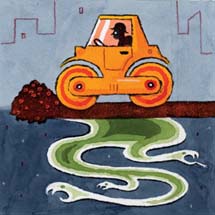 |
 |
| current issue |  | past issues |  | send a letter/news |  | address update |  | advertise |  | about us |  | alumni home |
|
Inquiring Minds By David Brooks Illustrations by Adam McCauley |
Easy to print version |
In this issue:
Treetop ViewFraught Lots
Science Defiance (Also read a longer version of this story)
Treetop View
Web cams in forests help measure climate change

|
Millions of people travel to New England each year to watch the leaves change with the season. It's a joy to behold and well worth the effort—so why are UNH researchers trying to automate the process?
"We're basically watching when and where photosynthesis is happening," says Steve Frolking, an associate professor in the Complex Systems Research Center at UNH's Institute for the Study of Earth, Oceans, and Space, speaking of the two-year-old Phenocam program, which involves a set of networked Web cams watching forests throughout the United States. "By looking at the green channel of the digital signal, you're seeing the effect of having a different amount of chlorophyll in the leaves relative to other material—seeing its chemistry, really."
Keeping an automated eye on North American forest chemistry isn't an exercise in arboreal voyeurism. It's a way to keep tabs on our continental ecosystem and through it our climate—in particular, the global carbon cycle. A number of systems do this but most involve remote sensing, usually from satellites or planes. Phenocam not only avoids clouds and the need for complex corrections for atmospheric effects, but it's cheap and constant enough to provide a detailed record over time.
Phenocam was started by Andrew Richardson, a CSRC professor who moved to Harvard this year. The technical aspects of the project continue to be overseen by UNH, although a score of other research groups are now involved. "We're not the first to think of this idea, but this is the first time that something like a network has been deployed to look at this on a large scale," says Bobby Braswell '90G, '96G, an affiliate research professor at CSRC who works at Atmospheric and Environmental Research, Inc. Braswell developed the computer code that retrieves the data and does the initial data processing.
A key part of Phenocam's value was the realization that the green channel in the standard red-green-blue digital signal could provide valuable information about seasonal changes in trees—their phenology. "A visual record is valuable enough in itself, but we went beyond that by generating a time series," says Braswell. "We try to understand how climate change affects the timing of the seasons."
That sounds like a lot to expect from off-the-shelf web cameras. And while after just two years there isn't enough data to be certain of its value, comparison with other sources of data has been encouraging, Braswell says. Best of all, other researchers are interested.
"At conferences, people come up to me and say, 'I've got this camera, and I wonder if you guys help me analyze it. You can have the data if you will help me make it work.'"
The company that sells the StarDot Netcam, Phenocam's camera of choice, advertises it as a way to generate live shots of things like crowds on Bourbon Street, but fails to note that it can be used to help measure global carbon cycles. The Phenocam project is trying to wring out even more useful information. Braswell says the group is working on programming scripts for a near-infrared filter, adding the spectrum beyond red. This, he says, would essentially turn the cameras into four-channel sensing devices, helping with the long-term goal of Phenocam: "We want to know how the ecosystem is behaving." See Phenocam at http://phenocam.unh.edu/gallery.html.
Fraught Lots
Coal-tar sealants can pollute the environment
It would be hard to conceive of a subject for scientific research that is less exotic than parking lot pavement material. Yet this most down-to-earth of topics—quite literally—is the target of a surprising amount of investigation. At UNH, these projects include ongoing research on pavement that filters rain water and the development of asphalt that recycles carbon-rich construction material, thus locking away a greenhouse gas.
Another project involves the surprisingly complicated question of quantifying how much toxin is produced by the most common type of parking lot sealant. Coal tar, a byproduct of carbonized coal, produces the shiny paving surface so beloved by homeowners and public-works directors, but it also produces polycyclic aromatic hydrocarbons (PAH), which are linked to cancer. As the pavement surface gets worn down by tires, snowplows and weather, PAH floats away or washes off into the environment, where it builds up over time. Everybody suspects it's a problem, but no one is sure how big a problem it is.
Enter UNH researchers Tom Ballestero, civil engineering associate professor, and Alison Watts '06G, research assistant professor, both with the Stormwater Center. Starting in the fall of 2007, a quarter-acre portion of one of the West Edge lots was covered with coal tar-based sealant, and a separate third of an acre got an asphalt-based coating. The rest of the nine-acre lot was left unsealed. For two years, researchers have tested stormwater draining off the site for PAH, and since spring, air samples and soil around the parking lot.

|
The results are startling: Concentrations of PAH in runoff was as high as 6,000 parts per billion from the coal-tar portions, compared to less than 10 ppb from unsealed portions. PAH releases after rain have consistently been two orders of magnitude higher from the coal-tar area. Initial sampling around the parking lots shows very high concentrations of PAH in the soil near the lots; concentrations of benzo[a]pyrene, a particularly harmful PAH, were detected at nearly 100 times the recommended level to protect human health. "People are unaware that there is a significant environmental impact with that kind of sealcoat," says Watts. "There should be significant human health concerns: people put this on the driveway their kids are playing on. It probably gets tracked into houses."
Actually, she says, it's not entirely true that people are unaware. Enough concern has been raised about coal-tar sealants that some communities have banned it, including Austin, Texas, in 2005 and Washington, D.C., in 2009. But the scientific backing for such bans remains shaky, which is why New Hampshire Sea Grant and the EPA are supporting the UNH parking lot study.
For her part, Watts thinks coal-tar sealcoat should probably be banned, particularly since safer alternatives, such as asphalt-based sealants, are available. She hopes that research like this will encourage developers and communities to reject the old, cheap way of making shiny parking lots.
"There's a strong analogy to green lawns," she says. "The easiest way to have a green lawn is to put a lot of chemicals on it. People don't realize the damage they're doing to the environment. The easiest way to have a shiny black driveway is to put this sealcoat on it, and people don't realize the damage there, either."
Science Defiance
Underperforming in science for an odd reason
Maori children in New Zealand, rural children in Taiwan, children of Mayan descendants in Belize, the Altai children of Siberia—disparate groups, to be sure, but many children in these regions lack interest in science, and struggle to connect their experience with science in school to the world around them.
That's lack of interest, not lack of aptitude for science, emphasize Michael Middleton and Eleanor Abrams, associate professors of education. Following initial interviews with children, parents, village elders and others, the professors believe that indigenous and rural schoolchildren shun science because it seems disconnected from their daily lives and to excel at it might require moving away from home.

|
"The kids do understand the subtext of what's happening around them," says Abrams. "They think, 'If I do well in science, they're going to make me leave—so I'm not going to do well.'"
The two began to focus on the issue after Abrams was in Taiwan to present research in 2005. There she met a researcher who was seeking a way to increase scientific literacy in indigenous children in a remote village. When Abrams realized that motivation was the problem, she approached Middleton, a colleague in the UNH education department and a former high school teacher who specializes in the topic. The joint project has expanded into Central America through an association with a Belize-New Hampshire teacher program, as well as New Zealand and Siberia. They hope to add Chippewa children and children north of the Notches in New Hampshire soon.
So far, the findings are a complicated mix of the universal and the specific. (Nobody said teaching was easy!) Across countries, they have found that raising interest in science education includes strong student-teacher relationships, the use of materials meaningful to kids and continuing academic support. They admit that this list wouldn't surprise anybody involved in education; however, they conclude that with indigenous children, there is no "best" way to apply these rules; it depends on the culture.
"How this occurs depends on the local context," says Middleton. "Our next step is to work with teachers in each community to support them in using their knowledge about local language, values and the natural environment in order to enhance students' interest and achievement in science." ~
blog comments powered by Disqus

